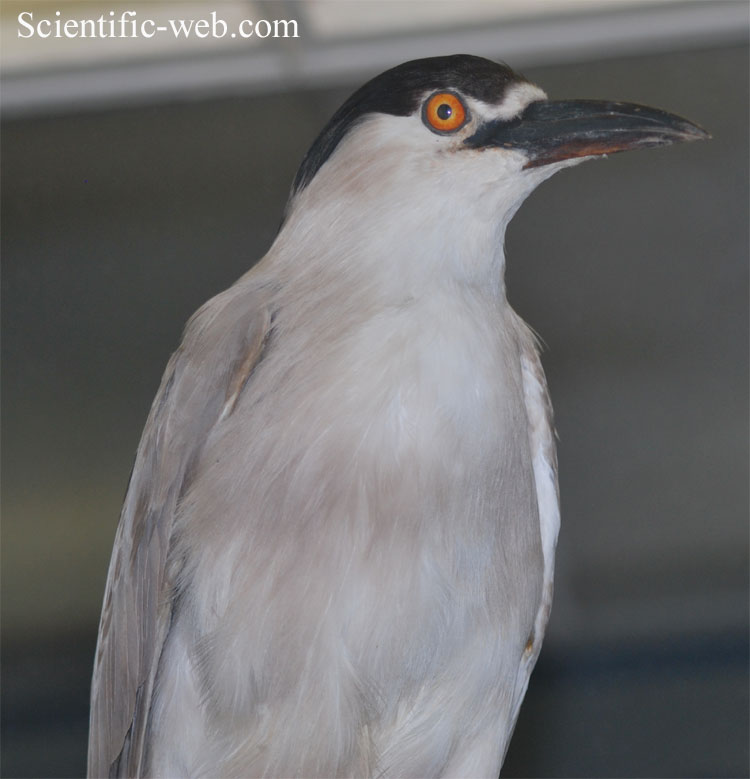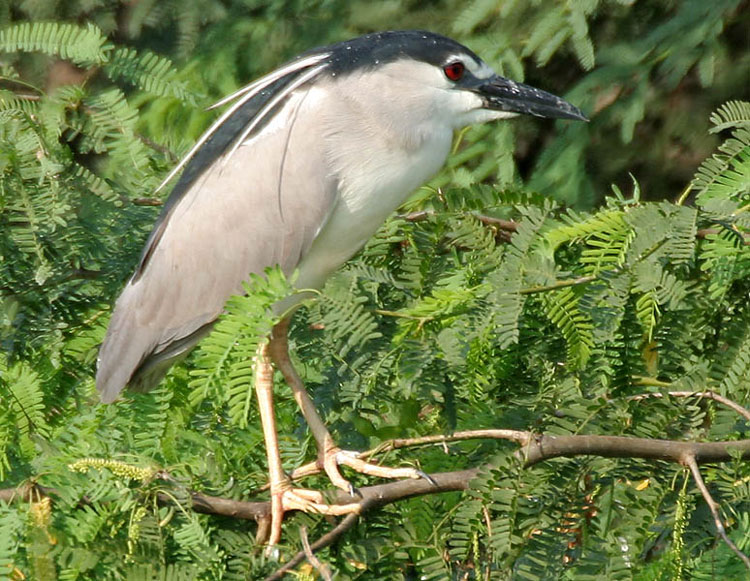
Nycticorax nycticorax , Photo: Michael Lahanas
Superregnum: Eukaryota
Cladus: Unikonta
Cladus: Opisthokonta
Cladus: Holozoa
Regnum: Animalia
Subregnum: Eumetazoa
Cladus: Bilateria
Cladus: Nephrozoa
Superphylum: Deuterostomia
Phylum: Chordata
Subphylum: Vertebrata
Infraphylum: Gnathostomata
Megaclassis: Osteichthyes
Cladus: Sarcopterygii
Cladus: Rhipidistia
Cladus: Tetrapodomorpha
Cladus: Eotetrapodiformes
Cladus: Elpistostegalia
Superclassis: Tetrapoda
Cladus: Reptiliomorpha
Cladus: Amniota
Classis: Reptilia
Cladus: Eureptilia
Cladus: Romeriida
Subclassis: Diapsida
Cladus: Sauria
Infraclassis: Archosauromorpha
Cladus: Crurotarsi
Divisio: Archosauria
Cladus: Avemetatarsalia
Cladus: Ornithodira
Subtaxon: Dinosauromorpha
Cladus: Dinosauriformes
Cladus: Dracohors
Cladus: Dinosauria
Ordo: Saurischia
Cladus: Eusaurischia
Subordo: Theropoda
Cladus: Neotheropoda
Cladus: Averostra
Cladus: Tetanurae
Cladus: Avetheropoda
Cladus: Coelurosauria
Cladus: Tyrannoraptora
Cladus: Maniraptoromorpha
Cladus: Maniraptoriformes
Cladus: Maniraptora
Cladus: Pennaraptora
Cladus: Paraves
Cladus: Eumaniraptora
Cladus: Avialae
Infraclassis: Aves
Cladus: Euavialae
Cladus: Avebrevicauda
Cladus: Pygostylia
Cladus: Ornithothoraces
Cladus: Ornithuromorpha
Cladus: Carinatae
Parvclassis: Neornithes
Cohors: Neognathae
Cladus: Neoaves
Cladus: Aequornithes
Ordo: Pelecaniformes
Familia: Ardeidae
Subfamilia: Nycticoracinae
Genus: Nycticorax
Species: Nycticorax nycticorax
Subspecies: N. n. falklandicus – N. n. hoactli – N. n. nycticorax – N. n. obscurus
Name
Nycticorax nycticorax (Linnaeus, 1758)
Synonymy
Ardea nycticorax (protonym)
Typus
"In Europa australi"

Nycticorax nycticorax (*)
References
Linnaeus, C. 1758. Systema Naturae per regna tria naturae, secundum classes, ordines, genera, species, cum characteribus, differentiis, synonymis, locis. Editio Decima, Reformata. Tomus I. Holmiæ (Stockholm): impensis direct. Laurentii Salvii. 824 pp. DOI: 10.5962/bhl.title.542 BHL p. 142 BHL Reference page.
Vernacular names
Afrikaans: Gewone nagreier
aragonés: Martinetz
العربية: بلشون الليل
asturianu: Garcina de Nueche
azərbaycanca: Adi qarıldaq
башҡортса: Ҡауылдаҡ селән
беларуская: Кваква звычайная
български: Нощна чапла
भोजपुरी: तार बकुला
বাংলা: নিশি বক
brezhoneg: Kerc'heiz-noz kein du
català: Martinet de nit
čeština: Kvakoš noční
Cymraeg: Crëyr y nos
dansk: Nathejre
Deutsch: Nachtreiher
ދިވެހިބަސް: ރާބޮނދި
Ελληνικά: Νυχτοκόρακας
English: Black-crowned Night Heron
Esperanto: Noktardeo
español: Martinete común
eesti: Ööhaigur
euskara: Amiltxori arrunt
فارسی: حواصیل کاکلسیاه
suomi: Yöhaikara
føroyskt: Nátthegri
français: Bihoreau gris
Frysk: Kwak
Gaeilge: Corr oíche
galego: Garza da noite
Avañe'ẽ: Tajasu guyra
ગુજરાતી: અવાક
Gaelg: Coar ny hoie
Hawaiʻi: 'Auku'u
עברית: אנפת לילה
हिन्दी: वाक
hrvatski: Gak kakavac
Kreyòl ayisyen: Kòk lannwit kouwòn nwa
magyar: Bakcsó
հայերեն: Կվակվա
Bahasa Indonesia: Kowak-malam Abu
íslenska: Nátthegri
italiano: Nitticora
日本語: ゴイサギ
ქართული: ღამის ყანჩა
қазақша: Бақылдақ құтан
ಕನ್ನಡ: ರಾತ್ರಿ ಬಕ
한국어: 해오라기
kernowek: Kerghyth nos
Lëtzebuergesch: Nuetsräer
lietuvių: Naktikovas
latviešu: Nakts gārnis
Malagasy: Doaka
македонски: Ноќна чапја
മലയാളം: പാതിരാക്കൊക്ക്
Bahasa Melayu: Burung Pucong Kuak
Malti: Kwakka
မြန်မာဘာသာ: လင်းဝက်
Nederlands: Kwak
norsk nynorsk: Natthegre
norsk: Natthegre
polski: Ślepowron zwyczajny
پنجابی: رات دا ہیرون
português do Brasil: Savacu
português: Goraz
Runa Simi: Waqwa
rumantsch: Irun stgarvunà
română: Stârc de noapte
русский: Обыкновенная кваква
srpskohrvatski / српскохрватски: Gak kakavac
slovenčina: Chvakoš nočný
slovenščina: Kvakač
shqip: Çapka e natës
српски / srpski: Ноћна чапља
Sesotho: Kokolofitoe
Sunda: Kowak-peuting kulawu
svenska: Natthäger
Kiswahili: Kingoyo Utosi-mweusi
தமிழ்: இராக்கொக்கு
ไทย: นกแขวก
Türkçe: Gece balıkçılı
українська: Квак
vèneto: Sgarzo
Tiếng Việt: Vạc
Bân-lâm-gú: Àm-kong
粵語: 夜鷺
中文: 夜鹭
isiZulu: uSiba
The black-crowned night heron (Nycticorax nycticorax), or black-capped night heron, commonly shortened to just night heron in Eurasia, is a medium-sized heron found throughout a large part of the world, including parts of Europe, Asia, and North and South America. In Australasia it is replaced by the closely related nankeen night heron, with which it has hybridized in the area of contact.
Contents
1 Description
2 Distribution
2.1 Status in Great Britain
3 Behaviour
4 Gallery
5 Parasites
6 Etymology
7 References
8 Further reading
9 External links
Description
Adults have a black crown and back with the remainder of the body white or grey, red eyes, and short yellow legs. They have pale grey wings and white under parts. Two or three long white plumes, erected in greeting and courtship displays, extend from the back of the head. The sexes are similar in appearance although the males are slightly larger. Black-crowned night herons do not fit the typical body form of the heron family. They are relatively stocky with shorter bills, legs, and necks than their more familiar cousins, the egrets and "day" herons. Their resting posture is normally somewhat hunched but when hunting they extend their necks and look more like other wading birds.
Immature birds have dull grey-brown plumage on their heads, wings, and backs, with numerous pale spots. Their underparts are paler and streaked with brown. The young birds have orange eyes and duller yellowish-green legs. They are very noisy birds in their nesting colonies, with calls that are commonly transcribed as quok or woc.
Measurements:[2]
Length: 22.8-26.0 in (58-66 cm)
Weight: 25.6-35.8 oz (727-1014 g)
Wingspan: 45.3-46.5 in (115-118 cm)
Distribution
The breeding habitat is fresh and salt-water wetlands throughout much of the world. The subspecies N. n. hoactli breeds in North and South America from Canada as far south as northern Argentina and Chile, N. n. obscurus in southernmost South America, N. n. falklandicus in the Falkland Islands, and the nominate race N. n. nycticorax in Europe, Asia and Africa. Black-crowned night herons nest in colonies on platforms of sticks in a group of trees, or on the ground in protected locations such as islands or reedbeds. Three to eight eggs are laid.
This heron is migratory in the northernmost part of its range, but otherwise resident (even in the cold Patagonia). The North American population winters in Mexico, the southern United States, Central America, and the West Indies, and the Old World birds winter in tropical Africa and southern Asia.
A colony of the herons has regularly summered at the National Zoo in Washington, D.C. for more than a century.[3] The birds also prominently live year-round in the shores around the San Francisco Bay, with the largest rookery in Oakland.[4] Their ever presence at Oakland's Lake Merritt and throughout the city's downtown area, as well as their resilience to the urban environment and displacement efforts, have led to them being named Oakland's official city bird.[4]
Status in Great Britain
There are two archaeological specimens of the black-crowned night heron in Great Britain. The oldest is from the Roman London Wall and the more recent from the Royal Navy's late medieval victualling yards in Greenwich.[5] It appears in the London poulterers price lists as the Brewe, a bird which was thought to have been the Eurasian whimbrel or Glossy ibis, which has now been shown to refer to the black-crowned night heron, derived from the medieval French Bihoreau.[6] Black-crowned night heron may have bred in the far wetter and wider landscape of pre-modern Britain. They were certainly imported for the table so the bone specimens themselves do not prove they were part of the British avifauna. In modern times the black-crowned night heron is a vagrant and feral breeding colonies were established at Edinburgh Zoo from 1950 into the 21st century[7] and at Great Witchingham in Norfolk where there were 8 pairs in 2003 but breeding was not repeated in 2004 or 2005.[8] A pair of adults were seen with two recently fledged juveniles in Somerset in 2017, which is the first proven breeding record of wild black-crowned night herons in Great Britain.[9]
Behaviour
Juvenile in an "upright" threat display.
These birds stand still at the water's edge and wait to ambush prey, mainly at night or early morning. They primarily eat small fish, crustaceans, frogs, aquatic insects, small mammals, and small birds. They are among the seven heron species observed to engage in bait fishing; luring or distracting fish by tossing edible or inedible buoyant objects into water within their striking range – a rare example of tool use among birds.[10][11] During the day they rest in trees or bushes. N. n. hoactli is more gregarious outside the breeding season than the nominate race.
Parasites
A thorough study performed by J. Sitko and P. Heneberg in the Czech Republic in 1962–2013 suggested that the central European black-crowned night herons host 8 helminth species. The dominant species consisted of Neogryporhynchus cheilancristrotus (62% prevalence), Contracaecum microcephalum (55% prevalence) and Opistorchis longissimus (10% prevalence). The mean number of helminth species recorded per host individual reached 1.41. In Ukraine, other helminth species are often found in black-crowned night herons too, namely Echinochasmus beleocephalus, Echinochasmus ruficapensis, Clinostomum complanatum and Posthodiplostomum cuticola.[12]
Etymology
Nycticorax means "night raven" and derives from the Ancient Greek nuktos, "night", and korax, "raven". It refers to the largely nocturnal feeding habits and croaking crow-like call of this species.[13]
In the Falkland Islands, the bird is called quark, which is an onomatopoeia similar to its name in many other languages, like qua-bird in English, kwak in Dutch and West Frisian, kvakoš noční in Czech, квак in Ukrainian, кваква in Russian, vạc in Vietnamese, kowak-malam in Indonesian, and waqwa in Quechua.
References
BirdLife International (2019). "Nycticorax nycticorax". IUCN Red List of Threatened Species. 2019: e.T22697211A155515762. doi:10.2305/IUCN.UK.2016-3.RLTS.T22697211A155515762.en. Retrieved 12 November 2021.
"Black-crowned Night-Heron Identification, All About Birds, Cornell Lab of Ornithology". www.allaboutbirds.org. Retrieved 26 September 2020.
Akpan, Nsikan (12 May 2015). "Smithsonian's mystery of the black-crowned night herons solved by satellites". PBS News Hour. PBS. Retrieved 2 May 2016.
"Oakland Has Its First Official Bird Thanks to These Dedicated Kids". Audubon. 24 May 2019. Retrieved 19 June 2021.
D.W. Yalden; U. Albarella (2009). The History of British Birds. Oxford University Press. ISBN 978-019-958116-0.
W.R.P. Bourne (2003). "Fred Stubbs, Egrets, Brewes and climatic change". British Birds. 96: 332–339.
R.W. Forrester; I.J. Andrews, eds. (2007). The Birds of Scotland Volume 1. Scottish Ornithologists' Club. ISBN 978-0-9512139-0-2.
Holling M. and the Rare Breeding Birds Panel (2007) Non-native breeding birds in the United Kingdom 2003, 2004 and 2005 British Birds 100 638–649
"Night Herons breed in Somerset - a UK first". Rare Bird Alert. Retrieved 2 August 2017.
Riehl, Christina (2001). "Black-Crowned Night Heron Fishes with Bait". Waterbirds: The International Journal of Waterbird Biology. 24 (2): 285–286. doi:10.2307/1522044. JSTOR 1522044.
Ruxton, Graeme D.; Hansell, Michael H. (1 January 2011). "Fishing with a Bait or Lure: A Brief Review of the Cognitive Issues". Ethology. 117 (1): 1–9. doi:10.1111/j.1439-0310.2010.01848.x. ISSN 1439-0310.
Sitko, J.; Heneberg, P. (2015). "Composition, structure and pattern of helminth assemblages associated with central European herons (Ardeidae)". Parasitology International. 64 (1): 100–112. doi:10.1016/j.parint.2014.10.009. PMID 25449288.
Jobling, James A (2010). The Helm Dictionary of Scientific Bird Names. London: Christopher Helm. p. 277. ISBN 978-1-4081-2501-4.
Further reading
Black-crowned night heron on Animal Diversity Web
Stiles, F. Gary; Skutch, Alexander F. (1990). A Guide to the Birds of Costa Rica. Cornell University Press. ISBN 978-0-8014-9600-4.
Hancock, James (1999). Herons and Egrets of the World. Academic Press. ISBN 978-0-12-322725-6.
Sibley, David (2000). The Sibley Guide to Birds. Knopf. ISBN 978-0-679-45122-8.
Retrieved from "http://en.wikipedia.org/"
All text is available under the terms of the GNU Free Documentation License

